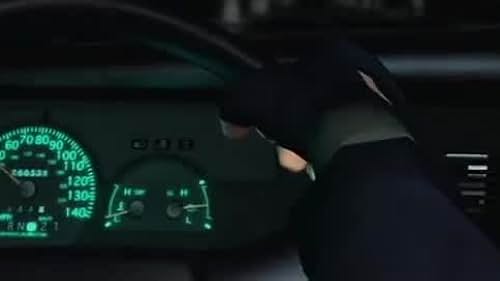IMDb RATING
9.1/10
6.7K
YOUR RATING
Two months after the mansion events, the deadly T-virus escapes into the streets of Raccoon City. Leon Kennedy and Claire Redfield find the police office left abandoned. In an underground fa... Read allTwo months after the mansion events, the deadly T-virus escapes into the streets of Raccoon City. Leon Kennedy and Claire Redfield find the police office left abandoned. In an underground facility the story of Umbrella Corp. gets unfolded.Two months after the mansion events, the deadly T-virus escapes into the streets of Raccoon City. Leon Kennedy and Claire Redfield find the police office left abandoned. In an underground facility the story of Umbrella Corp. gets unfolded.
- Awards
- 2 nominations
Paul Haddad
- Leon S. Kennedy
- (voice)
Alyson Court
- Claire Redfield
- (voice)
Sally Cahill
- Ada Wong
- (voice)
Lisa Jai
- Sherry Birkin
- (voice)
- (as Lisa Yamanaka)
Jennifer Dale
- Annette Birkin
- (voice)
Rod Wilson
- Ben Bertolucci
- (voice)
Gary Krawford
- Brian Irons
- (voice)
Diego Matamoros
- William Birkin
- (voice)
- (as Diego Matamores)
Katsutoshi Karatsuma
- Tofu
- (voice)
- (uncredited)
Evan Sabba
- Zombified Brad Vickers
- (voice)
- (uncredited)
- Director
- Writers
- All cast & crew
- Production, box office & more at IMDbPro
Storyline
Did you know
- TriviaA group of fans were remaking Resident Evil 2 in its entirety with Unreal Engine 4, named 'Resident Evil 2: Reborn'. This version was to feature improved 3D models, animations, textures, lighting, particle effects, scripts, and sound effects. Resident Evil 2: Reborn also featured an option to play the game with the classic static camera angels or with the over-the-shoulder camera style from Resident Evil 4. This was a nonprofit project, and was planned to be released in late 2015 on PC for free. On August 17th, 2015, Capcom announced they had politely requested the Reborn project to be canceled as they were working on an official Resident Evil 2 remake. The team developing Resident Evil 2: Reborn agreed to cancel, and were invited to Capcom to add their input on the official remake, Resident Evil 2 (2019).
- GoofsAt the near end of the A scenario in the final boss fight, the word "ELEVATER" on the floor is misspelled. It's suppose to have an "O-R" at the end of the word.
- Alternate versionsThe Nintendo 64 version lacked Extreme Battle Mode, but contained many new features not in any versions. The intro clip shown before the main menu contained different footage. Ex Files, a new set of documents were added along with the previous files and detailing events from Resident Evil 0, 1, 3, Code: Veronica and other info involving the series. Violence Control and a Blood Color mode were also added. New sets of hidden costumes were given to both Leon and Claire replacing the previous ones. A 3rd person controller system, Auto-Aim, and Rumble and Expansion Pack support were added. Randomizer Mode which gives more replay value and difficulty, gets unlocked on the menu by completing a scenario. The Randomizer always sets different items in every new game to make it feel more brand new and unpredictable. Passwords have been changed and files have been corrected in this version. Plus, a dead monster is given a cameo appearance.
- ConnectionsEdited into Resident Evil 2: Roundtable (2019)
Featured review
The quest of video games to be more and more like the real-life equivalent of the situation they are depicting is one stretching back as far as the late 1970s, when such titles as Galaga were over the horizon. Indeed, in the mid-1980s, one game based on a laserdisc and knowing which button to push when was hailed as raising the interactive bar to something we had never seen before. While video games based upon films were frequently made, and even sold in great numbers, Capcom set the standard when they took George Romero's Night Of The Living Dead and used it as the basis for Biohazard, or Resident Evil as it is known to English-speaking audiences (presumably because the original name was previously copyrighted outside of Japan).
Resident Evil 2 picks up a little after the original game in the series. The virus that the evil Umbrella corporation has been researching managed to get out into the open, and people have been dropping dead like flies as a result. The story begins when two central characters are separated in a car crash, and both try to survive long enough to work out what on Earth is going on in Racoon City. It sounds like a very basic, even threadbare plot, and to tell the truth, it is. But therein lies the charm of Resident Evil and most all of its sequels. One can go anywhere, do anything, kill anything, and apart from the frustration of winding up with nowhere to go at times, the game will not penalise the player for it. In this day and age where racing simulators are nothing more than knowing which lever to jerk when, it makes for a nice change.
Of course, as the main influence makes clear, the player soon finds themselves battling with undead citizens (and worse) throughout the course of the game. Those who like to kill everything in sight may find the going a little tough, as the game rewards the player for knowing what to kill and when. A zombie in a wide, open area does not require immediate shooting, but a licker in a confined space should be put down as quickly and quietly as possible. Knowing the difference can literally decide whether you complete this game or not. But if one does get into a situation where they are low on ammunition and are not sure where they are meant to go, they can simply keep exploring until a solution presents itself. Such is the quality of the artwork on offer that it takes a while for this to become boring.
One criticism of the game that is perfectly valid is that the zombie models only seem to have four varieties. Occasionally, different types will appear if certain conditions are met, such as not picking up any items during the trip to the police station, but for the most part, it is a rather generic bunch. Another problem is the save point system, which can make the quest seem repetitive at times if resumed. However, the fun of the game truly lies in revealing threads of the plot, which, while occasionally cliché, is put together like an elegant series of Chinese boxes. Questions are raised constantly, and half the fun is in finding the answers. In a complete contrast to the second feature film, the motions and attacks of the enemy are completely consistent, and even make sense from a biological point of view. One other criticism I have that applies to all of the Resident Evil games I have played to date is that in so-called tense moments, when a mass-attack by zombies or other terrors begins, one can often tell when they have completely beaten off their opposition by when the background music calms down. Although I am not entirely sure that is a bad thing.
The replay value of the game is heightened by the ability to complete one character's quest, save the results, and use them on the other's. What one does in one game directly affects what happens in the other. Decisions such as who should take the submachine gun, for example, are of great importance in the game, as are such things as opening doors or killing certain major enemies. Getting into the underground lab towards the end of the game is quite a chilling moment, too. Notwithstanding the fight that takes place on the way down, this deserted research lab is enough to put the wind up any a dedicated viewer of horror films. A contrast, as it were, to the godawful second film adaptation.
If I were giving Resident Evil 2 a score, it would be ten out of ten. Sure, it is looking old considering it was originally released on the PlayStation and Dreamcast, but unlike the vast majority of games, it has the ability to withstand the test of time. It is well worth hunting around the stores that specialise in second-hand or liquidated stock for.
Resident Evil 2 picks up a little after the original game in the series. The virus that the evil Umbrella corporation has been researching managed to get out into the open, and people have been dropping dead like flies as a result. The story begins when two central characters are separated in a car crash, and both try to survive long enough to work out what on Earth is going on in Racoon City. It sounds like a very basic, even threadbare plot, and to tell the truth, it is. But therein lies the charm of Resident Evil and most all of its sequels. One can go anywhere, do anything, kill anything, and apart from the frustration of winding up with nowhere to go at times, the game will not penalise the player for it. In this day and age where racing simulators are nothing more than knowing which lever to jerk when, it makes for a nice change.
Of course, as the main influence makes clear, the player soon finds themselves battling with undead citizens (and worse) throughout the course of the game. Those who like to kill everything in sight may find the going a little tough, as the game rewards the player for knowing what to kill and when. A zombie in a wide, open area does not require immediate shooting, but a licker in a confined space should be put down as quickly and quietly as possible. Knowing the difference can literally decide whether you complete this game or not. But if one does get into a situation where they are low on ammunition and are not sure where they are meant to go, they can simply keep exploring until a solution presents itself. Such is the quality of the artwork on offer that it takes a while for this to become boring.
One criticism of the game that is perfectly valid is that the zombie models only seem to have four varieties. Occasionally, different types will appear if certain conditions are met, such as not picking up any items during the trip to the police station, but for the most part, it is a rather generic bunch. Another problem is the save point system, which can make the quest seem repetitive at times if resumed. However, the fun of the game truly lies in revealing threads of the plot, which, while occasionally cliché, is put together like an elegant series of Chinese boxes. Questions are raised constantly, and half the fun is in finding the answers. In a complete contrast to the second feature film, the motions and attacks of the enemy are completely consistent, and even make sense from a biological point of view. One other criticism I have that applies to all of the Resident Evil games I have played to date is that in so-called tense moments, when a mass-attack by zombies or other terrors begins, one can often tell when they have completely beaten off their opposition by when the background music calms down. Although I am not entirely sure that is a bad thing.
The replay value of the game is heightened by the ability to complete one character's quest, save the results, and use them on the other's. What one does in one game directly affects what happens in the other. Decisions such as who should take the submachine gun, for example, are of great importance in the game, as are such things as opening doors or killing certain major enemies. Getting into the underground lab towards the end of the game is quite a chilling moment, too. Notwithstanding the fight that takes place on the way down, this deserted research lab is enough to put the wind up any a dedicated viewer of horror films. A contrast, as it were, to the godawful second film adaptation.
If I were giving Resident Evil 2 a score, it would be ten out of ten. Sure, it is looking old considering it was originally released on the PlayStation and Dreamcast, but unlike the vast majority of games, it has the ability to withstand the test of time. It is well worth hunting around the stores that specialise in second-hand or liquidated stock for.
- mentalcritic
- Apr 16, 2005
- Permalink
Details
- Release date
- Countries of origin
- Official site
- Language
- Also known as
- Обитель зла 2
- Production companies
- See more company credits at IMDbPro
Contribute to this page
Suggest an edit or add missing content


















